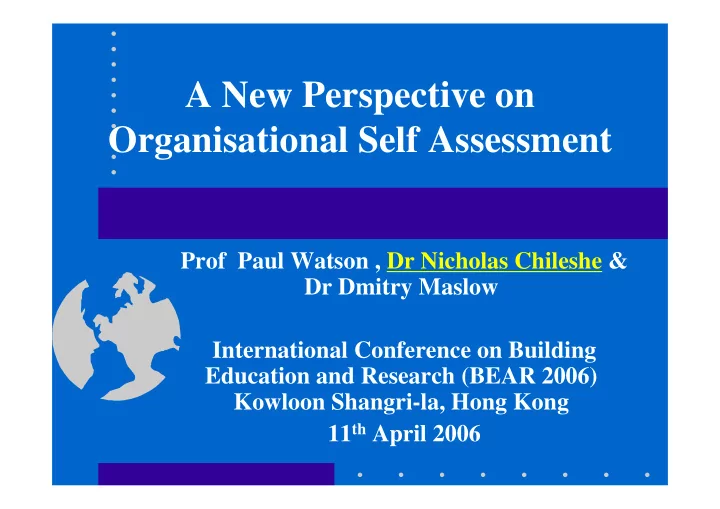

A New Perspective on Organisational Self Assessment Prof Paul Watson , Dr Nicholas Chileshe & Dr Dmitry Maslow International Conference on Building Education and Research (BEAR 2006) Kowloon Shangri-la, Hong Kong 11 th April 2006
Outline of Presentation • Introduction • Background • Aims and Objectives of the Research • Research Methodology • Major Findings • Limitations • Conclusions
Introduction • Definition of a Organisational Self Assessment • Sustainable Competitive Advantage • Existing Models - ‘Deming, MBNQA, EFQM EM, SACEM’ • Management Functional Assessment Model’ (MFAM) - Model Constituent Parts - Application
Background to Research • Rationale behind Organisational Self Assessment • Key Concepts of Leadership, Personnel and Development • MFAM Model addresses the critical issue of competitive advantage • Based on previous works of Deming, MBNQA and EFQM EM • Originality in providing the linkages between organisational activities
Aims & Objectives of the Research • To explore the linkages between organisational activities within a framework of corporate profitability and stakeholder satisfaction, and corporate excellence • To develop a MFAM for addressing the critical issue of competitive advantage.
Research Methodology Phase 1: Exploratory in nature Phase 2: Quantitative Approach based on questionnaire survey (Russia and UK)
Competitive-Oriented Management Fig 1.0: Three Principles of Competitive Achievement Sustainable Org Competitiveness Personnel Management System Leadership Development
Constituent Parts of the Tetrahedron Leadership • Role of Senior Management Critical to the success of any change ( employees have to be given time and skills) Personnel • Employers have to be motivated to engage in culture (Empowerment) Development • Consideration of both business processes and environmental issues
Linkages between TQM and CA • TQM Improved their efficiency and effectiveness. Other Sources of Competitive Advantage • Benchmarking Best Practice ( Shakantu and Talukhaba, 2002) • Organisation Learning ( Jashapara, 2003) • Alliances (Ngowi, 2001) • TQM Chileshe and Watson (1997; 2000)
Management Functional Assessment Model 1. Forecasting and Planning (Future Strategy) 2. Organising (Business Processes) 3. Motivation 4. Control (Dependent upon constant feedback) 5. Co-ordination 6. Communication (Measured within the context of five other functions)
Components of MFAM (Figure 2.0) MFAM Estimation Part Scoring Criteria 2.0 Four Score Approach 1.0 Marking Criteria 3.0 Summary of Results
Application of MFAM Estimation Part Table 1.0: Marking Criteria for MFAM Criteria Assessment Category Max Score 1. Planning 1.1 through 1.5 20 2. Organising 2.1 through 2.5 20 3. Motivation 3.1 through 3.5 20 4. Control 4.1 through 4.5 20 5. Coordinating 5.1 through 5.5 20 100 Total Management Estimation
Application of MFAM • Calculation of Criterion Total (CT) 5 CT = ∑ W i x i ............................ Equation 1 n= 1 Where W = score of the attribute Min = 0 and Max = 4 n = number of divisions in item scale
Application of MFAM – Criteria for Scoring Table 2.0: Scoring Criteria Score Criteria for Scoring 0 No activity demonstrated 1 Activity not consistently utilised 2 Activity is deployed but dependent upon the situation 3 The activity is deployed permanently and systematically 4 The activity is deployed permanently and systematically, monitored and reviewed via benchmarking for improvement
Application of MFAM • Example of Application Criteria Assessment Category Max Score 1. Planning 1.1 Setting the objective 4 1.2 Gathering and analysing 4 information related to clients and markets 1.3 Detailing business-processes 4 1.4 Gathering and analysing the 4 information about competitors and benchmarking 4 1.5 Resources planning 20 Criterion Total
Application of MFAM Table 3.0 : Summary of Results Level Total Score Assessment I 0-20 No Methodology or System II 21-40 Potential for Development III 41-60 Systems are in evidence IV 61-80 Constant quality checks V 81-100 Maximum Outcomes
Communicating MFAM Pentagonal Profile 20 Fig 3.0 Co-ord Org Motivation 20 20 For/Pln Control 20 20 Corporate Profile
Potential Application of MFAM • Managerial Implications of MFAM • Process Improvement • Attainting an organisation’s objectives • Benchmarking Key Performance Indicators (KPI’s) • Development of Clear, concise action plans resulting in a focussed policy and strategy • Integration of Improvement initiatives into normal operational activities • Development of group/team dynamics
Application of RADAR Figure 4.0 Action Plan Check Do
The Deming Plan, Do, Check, Action Action : Possible Change of Plan based on the Diagnosis Plan: Policy Deployment Do: Policy development Check: Auditing Diagnosing Reporting
Conclusions The Good • Recognises that sustainable excellence in all aspects of performance • MFAM addresses the key deployment issues and empowers the resulting benefits The Bad • Not Empirically Validated The Ugly • Still in the development Phase • Potential for bias due to self assessment
Any Questions ? Thank You… The End
Recommend
More recommend